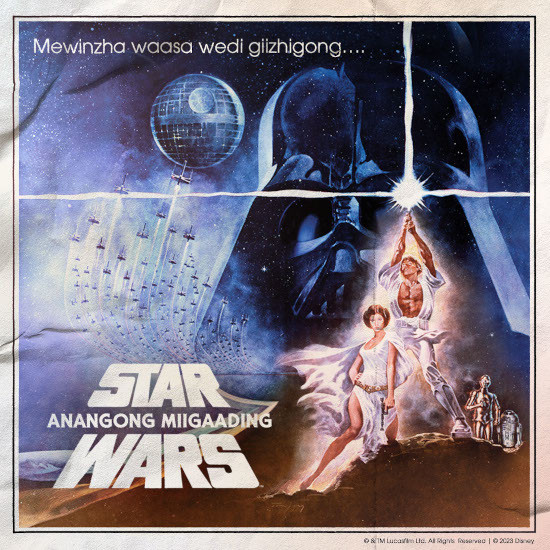Coming soon to a theatre near you and a galaxy far, far away
Lucasfilm and U of M scholars team up for an Ojibwe translation

Supplied photo - The poster for Anangong Miigaading, the upcoming Anishinaabemowin (Ojibwe) dub of Star Wars.
On Dec. 18, Star Wars fans were greeted with a surprise announcement. This time, though, it wasn’t just another spinoff movie slated for development or a new line of action figures.
While many fans may be well-versed in fictional languages like Huttese and droidspeak, they’ll soon have a new Indigenous language to add to their repertoire.
Lucasfilm, the University of Manitoba (U of M), the Dakota Ojibway Tribal Council and APTN are collaborating to translate Star Wars: A New Hope into Anishinaabemowin (Ojibwe).
“What this project is about is bringing more media in our language,” Dr. Cary Miller, a project lead and associate vice-president of Indigenous scholarship, research and curriculum at the U of M, says.
“Some of the reasons why language isn’t passing on to our next generations is the lack of media. You can even see in some communities that point in which there’s a significant shift in media access. It correlates to fluency decline.”
Anishinaabemowin is one of the most widely spoken Indigenous languages in North America with more than 300,000 speakers across the continent and a particularly high concentration in Manitoba.
Dougald Lamont, former leader of the Manitoba Liberal Party, was inspired by Lucasfilm’s prior Navajo dub of the classic 1977 film. Miller says Lamont “reached out to Dakota Ojibway Tribal Council. Pat Ningewance, our Anishinaabe language faculty member at the U of M, is probably the foremost scholar on Ojibwe language preservation in Canada. That brought the involvement of the university.”
After receiving a Canadian Heritage grant, the project was off at many parsecs per hour. While Lucasfilm will oversee production and handle logistics, the endeavour will heavily rely on the expertise of fluent speakers like Ningewance during the audition period.
Miller believes a translation of an accessible and beloved classic will help preserve and proliferate Anishinaabemowin while highlighting its practical applications.
“The perception is that (Anishinaabemowin) is not a skill or benefit. It’s something to compensate for. The heritage of education in Canada has led people to feel that the language is a hindrance,” she says.
“Careers can be made based in knowledge of the language as translators and teachers. For the youth, having this film in their language makes them see their language in a different way.”
Beyond the cultural and educational potential of screening Anangong Miigaading (that’s Star Wars in Ojibwe), the dubbing has personal significance to the passionate team behind it.
“The bottom line is it captures the heart and the mind. I saw the first film when I was six or seven. I must have seen it five times, begging Mom and Dad to see it one more time. (Project lead) Maeengan Linklater’s son has ‘Jedi’ as a middle name,” Miller says.
“It’s a labour of love for everybody who has initiated this project ... We’re doing it for our passion for the work and the language.”
While the film is in the early stages with no projected release date yet, Miller hopes their work will usher in a new era of fluency in the galaxy.
“(We) want to bring popular culture into our languages, so that the things kids want to watch have that voice. The more places the language is reinforced, the more likely fluency is to be maintained,” she says.
Published in Volume 78, Number 14 of The Uniter (January 18, 2024)






